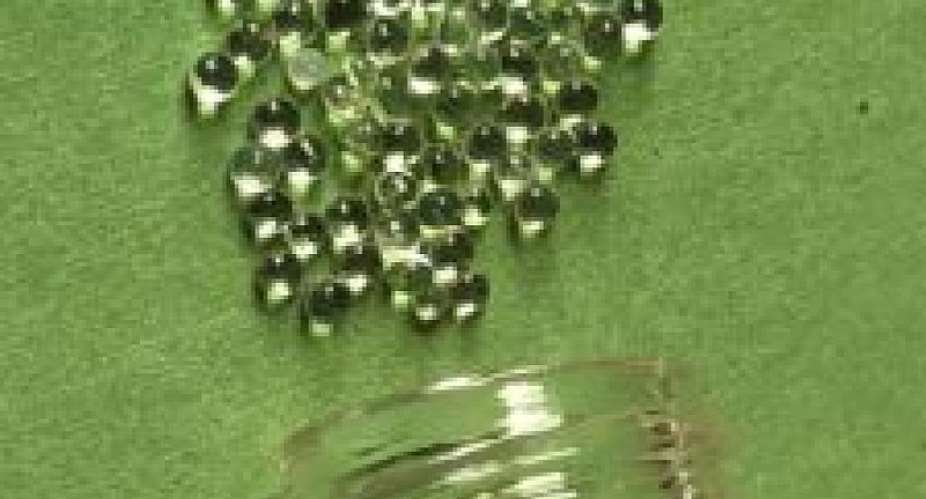With growing awareness of the problem of plastics entering the waters across the globe, people worldwide are searching for new and innovative alternatives. One laboratory has done just that to replace microplastic beads with plant-based version.
Microbeads are defined as man-made solid plastic particles less than one millimetre in size.
In commercially available items, they can measure anywhere from 10 micrometres to one millimetre, making them very hard to detect.
They are mostly found in the cosmetic industry in toothpaste, deodorant, shower gels and exfoliants, but also exist in household cleaners and in paints.
But because they are so small, they remain undetectable in the environment.
While there's no known threat to human ingestion, they do clog up the digestive systems of aquatic species or if ingested in large amounts, can be toxic.
Already certain countries have begun to phase them out or right-out ban their use, such as the United States, Canada, New Zealand, the UK and the EU.
But one laboratory in the English city of Bath has created an alternative: biodegradable cellulose microparticles or simply naturbeads.
These are made of 100 percent cellulose that can be transformed into a spherical form Giovanna Laudisio, the CEO of Naturbeads told RFI.
The fact that they can be made into a similar shape means they have the potential to easily replace the plastic version.
Sustainable and environmentally friendly
The issue with producing new alternatives to current products is not only are they environmentally friendly, but are they sustainable.
It's hard to justify a major switch to an item that will destroy acres and acres of plants to create one product.
“At the moment we are using commercially available cellulose, but in the future we plan to source cellulose from waste and in fact, after the announcement, we've been contacted by a company making hemp, which they told us is 70 percent cellulose. They were looking to collaborate so that we can source cellulose form plants which do not compete for food” explains Laudisio.
Cellulose is one major component of a plant's cell wall that reinforces the plant stems, leaves and branches.
And so the aim of the Laudisio's product is to create a sustainable substitution that is both environmentally friendly and economical.
“We want to move towards a circular process in which we use waste and produce a usable material […] we also aim to recycle all of our solvents because this will make the process environmentally friendly and cost-effective” states the CEO.
Harmful by-product?
The ingredient in the microbeads is cellulose. And cellulose, while not water soluble, does biodegrade in the environment.
The cellulose would end up in a water treatment plant or marine environment where it is in contact with enzymes and bacteria.
Based on her laboratory's preliminary data, when in contact with enzymes and bacteria, the cellulose degrades, leaving behind sugar as a by-product.
So “it won't be harmful to the fauna in the oceans, unlike plastic beads”.
Market penetration
The cosmetic industry already uses cellulose in some of its products.
And with more countries looking to ban microplastics beads because it is considered an “avoidable single use waste” the time is right for looking for an alternative.
“So we will start with the cosmetic industry, which is currently actively looking for substitution of plastic microbeads” says Laudisio.
Outside of the cosmetics industry, penetration may prove harder.
"Plastic microbeads are found in paints and coatings. They are used for stripping paints from airplanes, they use it for fillers in composites. . .They have a longer life but eventually they may still arrive in the environment” the CEO is quick to point out.
Which means those industries will soon be looking for options.
“Indeed we've been contacted by companies in packaging, companies in painting and coating, companies in building materials and even a shoe design!” she adds.
Production of naturbeads
At present, the production of naturbeads hasn't gone further than the laboratory.
But the manufacturing is “based on industrially proven technologies”.
So with the money coming from investors, Laudisio says they hope to build a pilot plant that can test the process and ultimately ensure it is cost-effective.
She adds that to ensure that cellulose stands up to other products, such as creams or oils in cosmetic uses, they will need to further develop the product to make sure it is a very stable material.





 This IMANI job no dey pap; the people you are fighting for are always fighting y...
This IMANI job no dey pap; the people you are fighting for are always fighting y...
 Prof. Naana Opoku-Agyemang has changed; you can see a certain sense of urgency –...
Prof. Naana Opoku-Agyemang has changed; you can see a certain sense of urgency –...
 MFWA Executive Director slams Akoma FM for engaging in ‘irresponsible’ media pra...
MFWA Executive Director slams Akoma FM for engaging in ‘irresponsible’ media pra...
 ‘Women must become millionaires too’ — Prof Jane Naana on establishment of Women...
‘Women must become millionaires too’ — Prof Jane Naana on establishment of Women...
 Some believe only in Ghanaian votes, not Ghana — Kofi Asare jabs politicians
Some believe only in Ghanaian votes, not Ghana — Kofi Asare jabs politicians
 Plan to make BEST sole aggregator of Sentuo Oil Refinery will create market chal...
Plan to make BEST sole aggregator of Sentuo Oil Refinery will create market chal...
 2024 elections: I can't have the man I removed from office as my successor — Aku...
2024 elections: I can't have the man I removed from office as my successor — Aku...
 2024 Elections: Immediate-past NPP Germany Branch Chairman garners massive votes...
2024 Elections: Immediate-past NPP Germany Branch Chairman garners massive votes...
 Gov’t focused on making Ghana energy self-sufficient, eco-friendly – Akufo-Addo
Gov’t focused on making Ghana energy self-sufficient, eco-friendly – Akufo-Addo
 April 25: Cedi sells at GHS13.74 to $1, GHS13.14 on BoG interbank
April 25: Cedi sells at GHS13.74 to $1, GHS13.14 on BoG interbank
